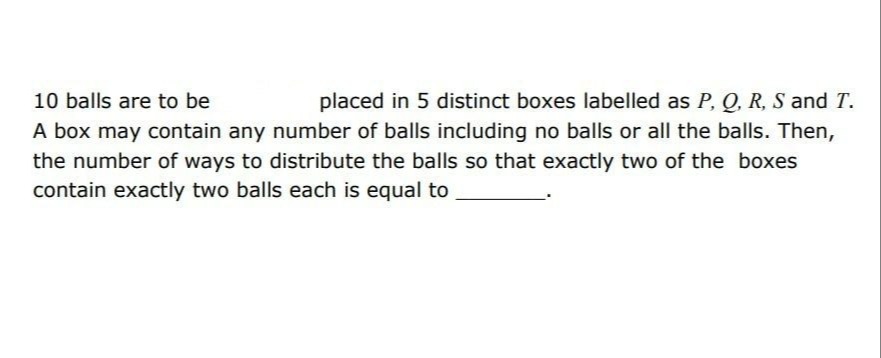Question
Question: 10 balls are to be placed in 5 distinct boxes labelled as $P, Q, R, S$ and $T$. A box may contain an...
10 balls are to be placed in 5 distinct boxes labelled as P,Q,R,S and T. A box may contain any number of balls including no balls or all the balls. Then, the number of ways to distribute the balls so that exactly two of the boxes contain exactly two balls each is equal to ______.

150
Solution
The problem requires distributing 10 identical balls into 5 distinct boxes such that exactly two boxes contain 2 balls each.
-
Choose the boxes: First, we select 2 out of the 5 distinct boxes that will contain exactly 2 balls. The number of ways to do this is given by the combination formula: (25)=2!(5−2)!5!=2×15×4=10
-
Distribute remaining balls: After placing 2 balls in each of the 2 chosen boxes, we have used 2+2=4 balls. This leaves 10−4=6 balls to be distributed among the remaining 5−2=3 distinct boxes. Let the number of balls in these remaining 3 boxes be n1,n2,n3. We have the equation n1+n2+n3=6, with the constraint that n1,n2,n3≥0 and none of these boxes can contain exactly 2 balls (i.e., n1=2,n2=2,n3=2).
We can solve this using the Principle of Inclusion-Exclusion (PIE).
-
Total ways to distribute 6 balls into 3 boxes: Using stars and bars, the total number of non-negative integer solutions is: (3−16+3−1)=(28)=28×7=28
-
Subtract cases where at least one box has 2 balls: Let Ai be the set of distributions where box i has exactly 2 balls.
- Exactly one box has 2 balls: Choose 1 box out of 3 ((13) ways). Place 2 balls in it. Distribute the remaining 6−2=4 balls into the other 2 boxes. The number of ways is (2−14+2−1)=(15)=5. So, (13)×5=3×5=15.
- Exactly two boxes have 2 balls: Choose 2 boxes out of 3 ((23) ways). Place 2 balls in each. This uses 2+2=4 balls. Distribute the remaining 6−4=2 balls into the last box. There is only 1 way to do this (place all 2 balls in the last box). So, (23)×1=3×1=3.
- Exactly three boxes have 2 balls: Choose 3 boxes out of 3 ((33) ways). Place 2 balls in each. This uses 2+2+2=6 balls. There is 1 way to do this. So, (33)×1=1×1=1.
Using PIE for the number of ways where at least one box has 2 balls: ∣A1∪A2∪A3∣=(sum of single cases)−(sum of double cases)+(triple case) ∣A1∪A2∪A3∣=15−3+1=13.
-
Number of ways where none of the 3 boxes has 2 balls: Total ways - (Ways with at least one box having 2 balls) = 28−13=15.
-
-
Total number of ways: Multiply the number of ways to choose the boxes by the number of ways to distribute the remaining balls: Total ways = (Ways to choose the 2 boxes) × (Ways to distribute remaining balls into the other 3 boxes such that none has 2 balls) Total ways = 10×15=150.
